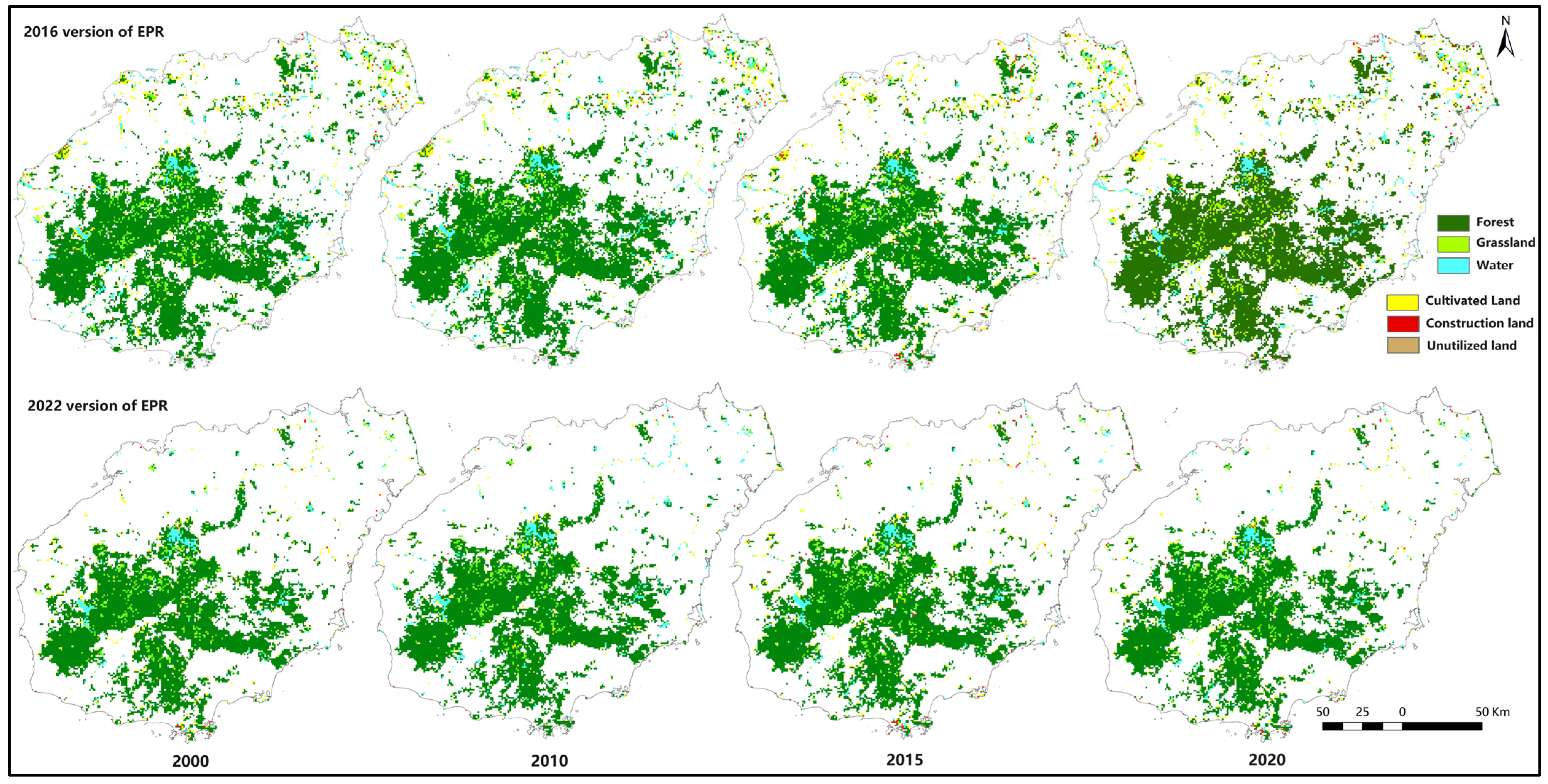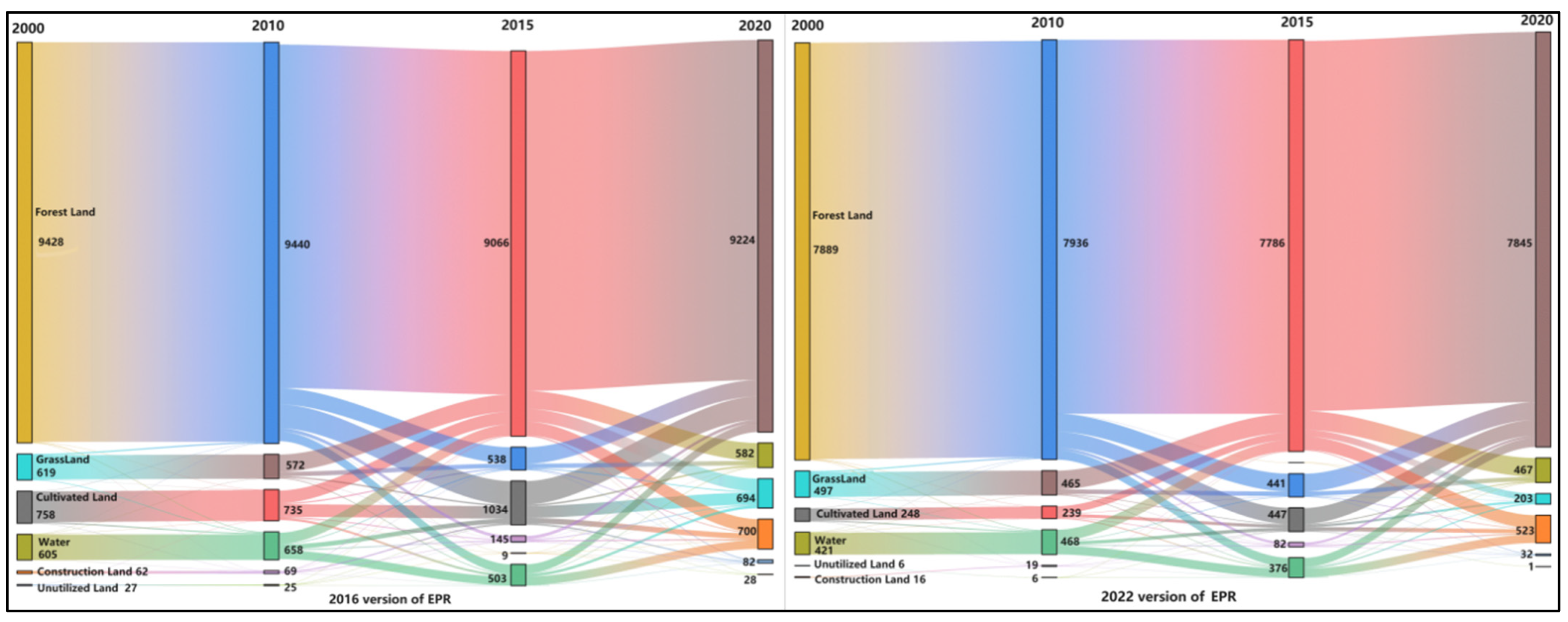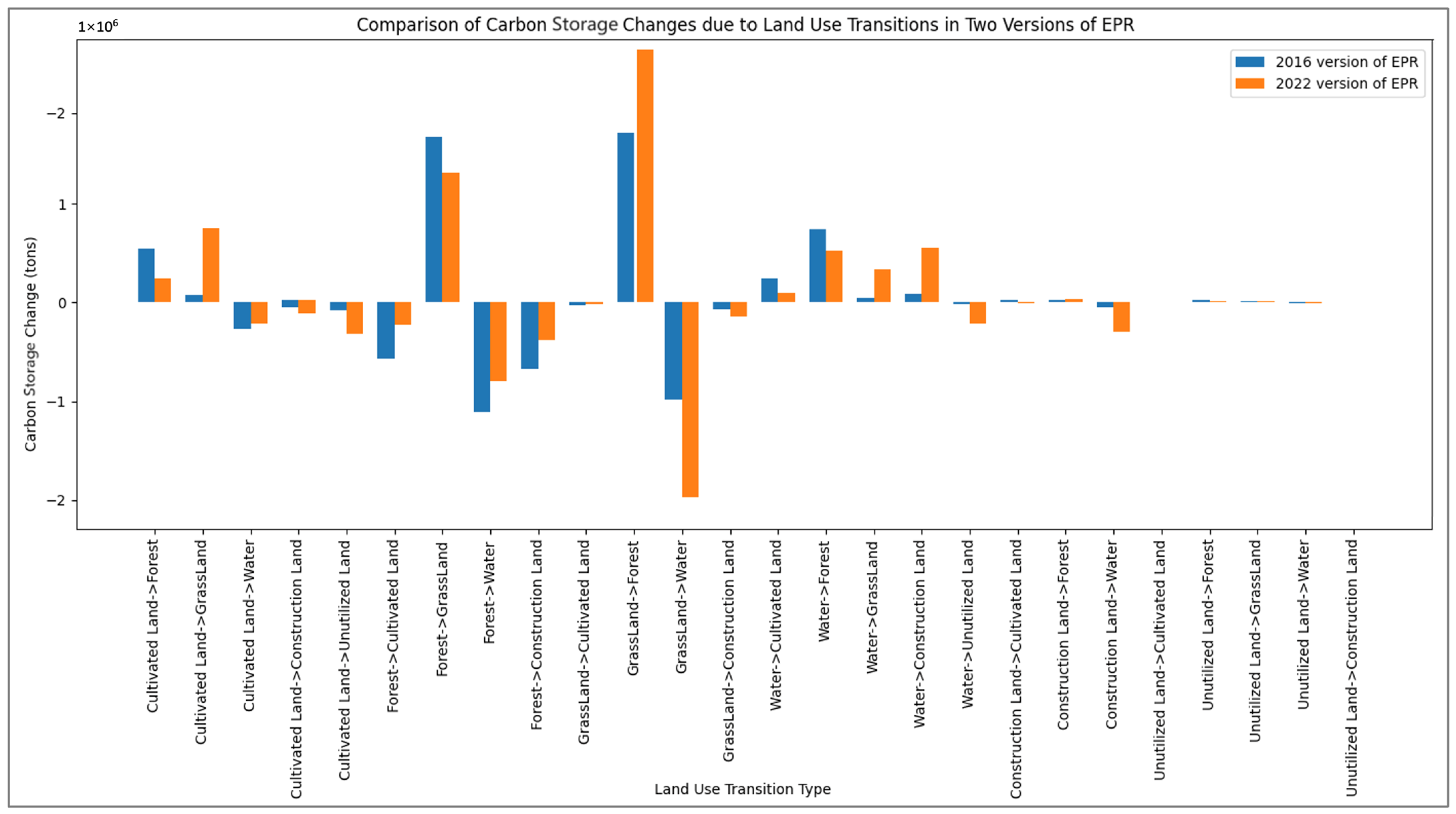Ecological Protection Redlines’ Positive Impact on Terrestrial Carbon Storage in Hainan Island, China
Abstract
:1. Introduction
2. Materials and Methods
2.1. Study Area
2.2. Data
2.3. Data Preparation
2.4. Land Use Dynamic Degrees and Transition Matrices
2.4.1. Land Use Dynamic Degrees
2.4.2. LULC Transition Matrix
2.5. Calculation of Carbon Storage Using InVEST Model
2.6. Spatial Autoregression Model
3. Results
3.1. Spatial Changes of EPR Land Use of Hainan Island
3.2. Comparison of the Spatiotemporal Trends of Carbon Storage inside and outside the EPR
3.3. Comparison of the Spatiotemporal Trends of Carbon Storage inside the EPR
3.4. Driving Forces Analysis of Carbon Storage Evolution in Hainan Island’s EPR
4. Discussion
4.1. EPRs’ Impact on Land Use Conversion
4.2. EPRs’ Impact on Carbon Storage and Driving Factors
4.3. Future Research
5. Conclusions
- (1)
- The 2022 EPR facilitated more accurate ecological protection and better performance in managing the relationships between ecological protection zones, permanent basic farmland, and urban development boundaries. In geographical terms, the 2016 EPR’s cultivated land was predominantly located in the eastern and central regions. The 2022 version showed a substantial reduction in cultivated land especially in the central areas, though it maintained overall stability from 2000 to 2020. Both versions exhibited similar trends in forest land changes, with the 2022 EPR enhancing forest conservation efforts, particularly in the central and northern peripheral zones. While the 2016 EPR focused on conserving cultivated land and grasslands, the 2022 EPR excelled in construction land control and water resource management, indicating a strategic shift towards integrated ecological and resource protection.
- (2)
- The 2022 version of the EPR has also significantly enhanced the connectivity and integrity of key ecological habitats within its designated boundaries. Although overall carbon storage within the EPR exhibited a declining trend due to the decreased coverage, the carbon storage per unit area in the 2022 version was relatively higher, indicative of a more cohesive, structurally sound, and functionally comprehensive zoning management. Furthermore, carbon storage distribution within the 2022 EPR became more concentrated, particularly with restoration observed in the agricultural and forested areas within the eastern and northern coastal cities of Hainan Island. The increase in carbon storage was primarily driven by land use transitions, notably the conversion of cultivated land to forest land, grassland to forest land, and water bodies to grassland. Additionally, there were notable decreases in carbon storage across Hainan Island, more pronounced within the boundaries of the EPR2016.
- (3)
- Elevation displayed a relatively positive correlation with carbon storage of both versions’ EPR, primarily due to the ecological characteristics of high-altitude regions of the central mountainous area where HTRNP is located with robust natural forests. These areas feature richer vegetation and more stable natural ecosystems, significantly contributing to enhanced carbon storage.
Author Contributions
Funding
Data Availability Statement
Conflicts of Interest
References
- Friedlingstein, P.; Jones, M.W.; O’Sullivan, M.; Andrew, R.M.; Bakker, D.C.; Hauck, J.; Le Quéré, C.; Peters, G.P.; Peters, W.; Pongratz, J. Global carbon budget 2021. Earth Syst. Sci. Data 2022, 14, 1917–2005. [Google Scholar] [CrossRef]
- Friedlingstein, P.; O’sullivan, M.; Jones, M.W.; Andrew, R.M.; Gregor, L.; Hauck, J.; Le Quéré, C.; Luijkx, I.T.; Olsen, A.; Peters, G.P. Global carbon budget 2022. Earth Syst. Sci. Data 2022, 14, 4811–4900. [Google Scholar] [CrossRef]
- Yu, C.; Zhang, Z.; Jeppesen, E.; Gao, Y.; Liu, Y.; Liu, Y.; Lu, Q.; Wang, C.; Sun, X. Assessment of the effectiveness of China’s protected areas in enhancing ecosystem services. Ecosyst. Serv. 2024, 65, 101588. [Google Scholar] [CrossRef]
- Black, B.; Anthony, B.P. Counterfactual assessment of protected area avoided deforestation in Cambodia: Trends in effectiveness, spillover effects and the influence of establishment date. Glob. Ecol. Conserv. 2022, 38, e02228. [Google Scholar] [CrossRef]
- Bai, Y.; Wong, C.P.; Jiang, B.; Hughes, A.C.; Wang, M.; Wang, Q. Developing China’s Ecological Redline Policy using ecosystem services assessments for land use planning. Nat. Commun. 2018, 9, 3034. [Google Scholar] [CrossRef] [PubMed]
- Li, S.; Liu, Y.; Yang, H.; Yu, X.; Zhang, Y.; Wang, C. Integrating ecosystem services modeling into effectiveness assessment of national protected areas in a typical arid region in China. J. Environ. Manag. 2021, 297, 113408. [Google Scholar] [CrossRef]
- Chen, H.; Zhang, T.; Costanza, R.; Kubiszewski, I. Review of the approaches for assessing protected areas’ effectiveness. Environ. Impact Assess. Rev. 2023, 98, 106929. [Google Scholar] [CrossRef]
- IUCN. Effective Protected Areas. Available online: https://www.iucn.org/our-work/topic/effective-protected-areas (accessed on 3 October 2023).
- Wu, R.; Ma, G.; Long, Y.; Yu, J.; Li, S.; Jiang, H. The performance of nature reserves in capturing the biological diversity on Hainan Island, China. Environ. Sci. Pollut. Res. 2011, 18, 800–810. [Google Scholar] [CrossRef]
- Zou, C.; XU MJ, L. Analysis on the connotation of ecological protection redline and suggestions on ecological protection redline drawing. Environ. Prot. 2015, 43, 54–57. [Google Scholar]
- Liang, X.; Jin, X.; Zhu, F.; He, J.; Zhang, X.; Zhang, M.; Fan, Y.; Hu, J.; Zhou, Y. Reflection on delimiting ecological protection red line (EPRL) in Middle-Lower Yangtze Plain: A case study of Jiangsu province. Acta Ecol. Sin. 2020, 40, 5968–5979. [Google Scholar]
- Xu, D.-L.; Zou, C.-X.; Lin, N.-F.; Wang, Y.; Xu, M.-J.; Wu, D.; Cao, B.-S. Building an Evaluation Indicator System for Assessing the Protection Effectiveness of Ecological Conservation Redline. J. Ecol. Rural Environ. 2020, 36, 1562–1568. [Google Scholar]
- Chen, H. The ecosystem service value of maintaining and expanding terrestrial protected areas in China. Sci. Total Environ. 2021, 781, 146768. [Google Scholar] [CrossRef] [PubMed]
- Zou, C.; Wang, L.; Liu, J. Classification and management of ecological protection redlines in China. Biodivers. Sci. 2015, 23, 716. [Google Scholar] [CrossRef]
- Kong, L.; Wang, Y.; Zheng, H.; Xiao, Y.; Xu, W.; Zhang, L.; Xiao, Y.; Ouyang, Z. A method for evaluating ecological space and ecological conservation redlines in river basins: A case of the Yangtze River Basin. Acta Ecol. Sin. 2019, 39, 835–843. [Google Scholar]
- Liu, J.; Ma, S.; Gao, J.; Zou, C.; Wang, J.; Liu, Z.; Wang, L. Delimiting the ecological conservation redline at regional scale: A case study of Beijing-Tianjin-Hebei region. China Environ. Sci. 2018, 38, 652–2657. [Google Scholar]
- He, H.; Wen, J.; Zhang, J.; Zeng, X.; Li, F. Ecological functions assessment of mangrove wetland in Hainan Province. Ecol. Econo. 2015, 31, 145–149. [Google Scholar]
- Ding, D.; Li, M.; Liao, B.; Dan, X. Evaluation of economic value of coastal natural wetland ecosystem services of Hainan province. Ecol. Environ. Sci. 2015, 24, 1472–1477. [Google Scholar]
- Li, T.; Hong, X.; Liu, S.; Wu, X.; Fu, S.; Liang, Y.; Li, J.; Li, R.; Zhang, C.; Song, X. Cropland degradation and nutrient overload on Hainan Island: A review and synthesis. Environ. Pollut. 2022, 313, 120100. [Google Scholar] [CrossRef]
- Wang, H.; Zeng, Y. Policy Optimization for Hainan Tropical Rainforest National Park Based on Quantitative Comparison of Regional Policies of Free Trade Port Areas. Front. Environ. Sci. 2022, 10, 891432. [Google Scholar] [CrossRef]
- Liu, Z.; Li, H.; Wu, F.; Wang, H.; Chen, H.; Zhu, Q.; Yang, G.; Liu, W.; Chen, D.; Li, Y.; et al. Quantification of Ecosystem-Scale Methane Sinks Observed in a Tropical Rainforest in Hainan, China. Land 2022, 11, 154. [Google Scholar] [CrossRef]
- Department of Natural Resources and Planning of Hainan Province. Regulations for the Management of Ecological Protection Red Lines in Hainan Province (2022 Amendment). Available online: https://lr.hainan.gov.cn/xxgk_317/0200/0202/202403/t20240313_3617540.html (accessed on 14 June 2024).
- Zhao, M.; He, Z.; Du, J.; Chen, L.; Lin, P.; Fang, S. Assessing the effects of ecological engineering on carbon storage by linking the CA-Markov and InVEST models. Ecol. Indic. 2019, 98, 29–38. [Google Scholar] [CrossRef]
- Houghton, R.A. Revised estimates of the annual net flux of carbon to the atmosphere from changes in land use and land management 1850–2000. Tellus. Ser. B Chem. Phys. Meteorol. 2003, 55, 378–390. [Google Scholar] [CrossRef]
- Zhou, J.; Zhao, Y.; Huang, P.; Zhao, X.; Feng, W.; Li, Q.; Xue, D.; Dou, J.; Shi, W.; Wei, W.; et al. Impacts of ecological restoration projects on the ecosystem carbon storage of inland river basin in arid area, China. Ecol. Indic. 2020, 118, 106803. [Google Scholar] [CrossRef]
- Yang, Y.; Li, H.; Qian, C. Analysis of the implementation effects of ecological restoration projects based on carbon storage and eco-environmental quality: A case study of the Yellow River Delta, China. J. Environ. Manag. 2023, 340, 117929. [Google Scholar] [CrossRef] [PubMed]
- Yang, M.; Xie, Y. Spatial pattern change and ecosystem service value dynamics of ecological and non-ecological redline areas in Nanjing, China. Int. J. Environ. Res. Public Health 2021, 18, 4224. [Google Scholar] [CrossRef]
- Guo, X.; Zhang, Y.; Guo, D.; Lu, W.; Xu, H. How does ecological protection redline policy affect regional land use and ecosystem services? Environ. Impact Assess. Rev. 2023, 100, 107062. [Google Scholar] [CrossRef]
- Liu, H.; Zhang, G.; Li, T.; Ren, S.; Chen, B.; Feng, K.; Li, W.; Zhao, X.; Qin, P.; Zhao, J. Importance of ecosystem services and ecological security patterns on Hainan Island, China. Front. Environ. Sci. 2024, 12, 1323673. [Google Scholar] [CrossRef]
- Zhang, X.; Jin, X.; Liang, X.; Shi, X.; Sun, R.; Zhu, W.; Lin, J.; Han, B.; Zhou, Y. Assessment and management for future habitat risks under the implementation of China’s territorial spatial planning: A case study from Hainan Island. Environ. Impact Assess. Rev. 2024, 106, 107474. [Google Scholar] [CrossRef]
- Yuan, L.; Geng, M.; Li, F.; Xie, Y.; Tian, T.; Chen, Q. Spatiotemporal characteristics and drivers of ecosystem service interactions in the Dongting Lake Basin. Sci. Total Environ. 2024, 926, 172012. [Google Scholar] [CrossRef]
- Jiang, B.; Wang, X.; Yang, M.; Cai, J. Application of ecosystem services research on a protection effectiveness evaluation of the ecological redline policy. Acta Ecol. Sin 2019, 39, 3365–3371. [Google Scholar]
- Feng, C.; Cao, M.; Wang, W.; Wang, H.; Liu, F.; Zhang, L.; Du, J.; Zhou, Y.; Huang, W.; Li, J. Which management measures lead to better performance of China’s protected areas in reducing forest loss? Sci. Total Environ. 2021, 764, 142895. [Google Scholar] [CrossRef] [PubMed]
- Anthony, B.P.; Shestackova, E. Do global indicators of protected area management effectiveness make sense? A case study from Siberia. Environ. Manag. 2015, 56, 176–192. [Google Scholar] [CrossRef] [PubMed]
- Resource Environment Data Center of the Chinese Academy of Sciences. Globeland30. Available online: https://www.resdc.cn/ (accessed on 3 May 2023).
- Li, L.; Huang, X.; Yang, H. Optimizing land use patterns to improve the contribution of land use planning to carbon neutrality target. Land Use Policy 2023, 135, 106959. [Google Scholar] [CrossRef]
- Department of Ecology and Environment of Hainan Province. Regulations for the Management of Ecological Protection Red Lines in Hainan Province. Available online: https://hnsthb.hainan.gov.cn/xxgk/0200/0202/hjywgl/stbh/201901/t20190106_2126022.html (accessed on 14 June 2024).
- Gao, J.; Zou, C.; Zhang, K.; Xu, M.; Wang, Y. The establishment of Chinese ecological conservation redline and insights into improving international protected areas. J. Environ. Manag. 2020, 264, 110505. [Google Scholar] [CrossRef] [PubMed]
- Guo, P.; Zhang, F.; Wang, H. The response of ecosystem service value to land use change in the middle and lower Yellow River: A case study of the Henan section. Ecol. Indic. 2022, 140, 109019. [Google Scholar] [CrossRef]
- The Natural Capital Project. Carbon Storage and Sequestration. Available online: http://releases.naturalcapitalproject.org/invest-userguide/latest/en/carbonstorage.html (accessed on 29 July 2024).
- Wang, H.; Zhu, Y.; Huang, W.; Yin, J.; Niu, J. Spatio-temporal evolution and driving mechanisms of rural residentials from the perspective of the human-land relationship: A case study from luoyang, China. Land 2022, 11, 1216. [Google Scholar] [CrossRef]
- Anselin, L.; Rey, S.J. Modern Spatial Econometrics in Practice, a Guide to Geoda, Geodaspace and Pysal; GeoDa Press: Chicago, IL, USA, 2014; Volume 29. [Google Scholar]
- Li, Y.; Yao, S.; Jiang, H.; Wang, H.; Ran, Q.; Gao, X.; Ding, X.; Ge, D. Spatial-temporal evolution and prediction of carbon storage: An integrated framework based on the MOP–PLUS–InVEST model and an applied case study in Hangzhou, East China. Land 2022, 11, 2213. [Google Scholar] [CrossRef]
- Meng, Y.; Gou, R.; Bai, J.; Moreno-Mateos, D.; Davis, C.C.; Wan, L.; Song, S.; Zhang, H.; Zhu, X.; Lin, G. Spatial patterns and driving factors of carbon stocks in mangrove forests on Hainan Island, China. Glob. Ecol. Biogeogr. 2022, 31, 1692–1706. [Google Scholar] [CrossRef]
- Lei, J.; Wu, T.; Chen, X.; Chen, Y.; Li, Y.; Chen, Z. Landscape Pattern Changes and Driving Factors Analysis of Wetland in Hainan Island during 1990-2018. Ecol. Environ. 2020, 29, 59–70. [Google Scholar]
- Wang, P.; Wang, J.; Zhang, J.; Ma, X.; Zhou, L.; Sun, Y. Spatial-temporal changes in ecosystem services and social-ecological drivers in a typical coastal tourism city: A case study of Sanya, China. Ecol. Indic. 2022, 145, 109607. [Google Scholar] [CrossRef]
- Li, R.; Zheng, H.; Polasky, S.; Hawthorne, P.L.; O’Connor, P.; Wang, L.; Li, R.; Xiao, Y.; Wu, T.; Ouyang, Z. Ecosystem restoration on Hainan Island: Can we optimize for enhancing regulating services and poverty alleviation? Environ. Res. Lett. 2020, 15, 084039. [Google Scholar] [CrossRef]
- Wu, W.; Huang, Z.; Sun, Z.; Zhang, J.; Wang, S.; Fang, M.; Yang, H.; Lu, H.; Guo, G.; Liu, W. Simulation and attribution analysis of terrestrial ecosystem carbon storage of Hainan Island from 2015 to 2050. Sci. Total Environ. 2024, 917, 170348. [Google Scholar] [CrossRef] [PubMed]
- Liu, Q.; Yang, D.; Cao, L.; Anderson, B. Assessment and prediction of carbon storage based on land use/land cover dynamics in the tropics: A case study of hainan island, China. Land 2022, 11, 244. [Google Scholar] [CrossRef]
- Zhang, Y.; Han, N.; Hu, K.; Yu, M.; Li, X. The impact of land-use changes on the spatio-temporal variation of carbon storage in the central mountainous area of Hainan Island. J. Nanjing For. Univ. 2023, 47, 115. [Google Scholar]
- Lin, M.; Song, Y.; Lu, D.; Qiu, Z. Geospatial environmental influence on forest carbon sequestration potential of Tropical forest growth in Hainan Island, China. Front. Environ. Sci. 2022, 10, 807105. [Google Scholar] [CrossRef]








| Data Types | Description | Resolution | Sources |
|---|---|---|---|
| Land cover data | LULC | 30 m × 30 m | Chinese Academy Resource and Environmental Data Platform (http://www.resde.cn/, accessed on 13 May 2024) |
| Geographical data | DEM | 100 m × 100 m | Geospatial Data Could (http://www.gscloud.cn/home, accessed on 13 May 2024) |
| Slope | |||
| NDVI | |||
| Meteorological data | Temperature | 500 m × 500 m | China Meteorological Data Service Centre (http://data.cma.cn/, accessed on 13 May 2024) |
| Precipitation | |||
| Socioeconomic data | Gross domestic product | 1000 m × 1000 m | Chinese Academy Resource and Environmental Data Platform (https://www.resdc.cn/, accessed on 13 May 2024) |
| Population density | |||
| Locality | Locality boundaries | Vector data |
| Land Use | Cabove | Cbelow | Csoil | Cdead |
|---|---|---|---|---|
| Cultivated land | 18.85 | 2.81 | 10.84 | 0 |
| Forest | 33.24 | 6.09 | 28.57 | 2.82 |
| Grass | 17.11 | 77.63 | 9.99 | 0.24 |
| Water | 0.35 | 1.45 | 3.03 | 1.24 |
| Construction land | 13.91 | 2.86 | 19.17 | 0 |
| Unutilized land | 13.18 | 2.61 | 0.93 | 0 |
| EPRs | 2000 | 2010 | 2015 | 2020 |
|---|---|---|---|---|
| EPR2016 | 61,763,178 | 61,185,366 | 60,737,906 | 60,525,588 |
| EPR2022 | 50,560,219 | 50,048,902 | 49,725,055 | 49,533,251 |
| Analysis | MI/DF | VALUE | PROB |
|---|---|---|---|
| Moran’s I (error) | 0.5486 | 12.9114 | 0.00000 |
| Lagrange Multiplier (lag) | 1 | 1.2246 | 0.00233 |
| Robust LM (lag) | 1 | 1.4546 | 0.53242 |
| Lagrange Multiplier (error) | 1 | 147.2546 | 0.00000 |
| Robust LM (error) | 1 | 147.4847 | 0.00000 |
| Impact Factor | Coefficient | Standard Error | z-Value | p-Value |
|---|---|---|---|---|
| Constant | 1.40 × 106 | 305266 | 4.58869 | 0.00120 |
| Temperature | −31770.4 | 12054.4 | −4.65059 | 0.00700 |
| Precipitation | 2.6074 | 0.0280888 | 92.8268 | 0.00000 |
| DEM | 118.97 | 179.313 | 0.663477 | 0.10811 |
| NDVI | 1.8646 | 6.76211 | 0.275742 | 0.07275 |
| GDP | −14.1982 | 7.78152 | −1.8246 | 0.06806 |
| Population Density | −1.07827 | 2.10303 | 0.512725 | 0.00814 |
Disclaimer/Publisher’s Note: The statements, opinions and data contained in all publications are solely those of the individual author(s) and contributor(s) and not of MDPI and/or the editor(s). MDPI and/or the editor(s) disclaim responsibility for any injury to people or property resulting from any ideas, methods, instructions or products referred to in the content. |
© 2024 by the authors. Licensee MDPI, Basel, Switzerland. This article is an open access article distributed under the terms and conditions of the Creative Commons Attribution (CC BY) license (https://creativecommons.org/licenses/by/4.0/).
Share and Cite
Zhang, Z.; Zhu, Y.; Jia, P. Ecological Protection Redlines’ Positive Impact on Terrestrial Carbon Storage in Hainan Island, China. Land 2024, 13, 1292. https://doi.org/10.3390/land13081292
Zhang Z, Zhu Y, Jia P. Ecological Protection Redlines’ Positive Impact on Terrestrial Carbon Storage in Hainan Island, China. Land. 2024; 13(8):1292. https://doi.org/10.3390/land13081292
Chicago/Turabian StyleZhang, Zhouyao, Yuxin Zhu, and Peihong Jia. 2024. "Ecological Protection Redlines’ Positive Impact on Terrestrial Carbon Storage in Hainan Island, China" Land 13, no. 8: 1292. https://doi.org/10.3390/land13081292








